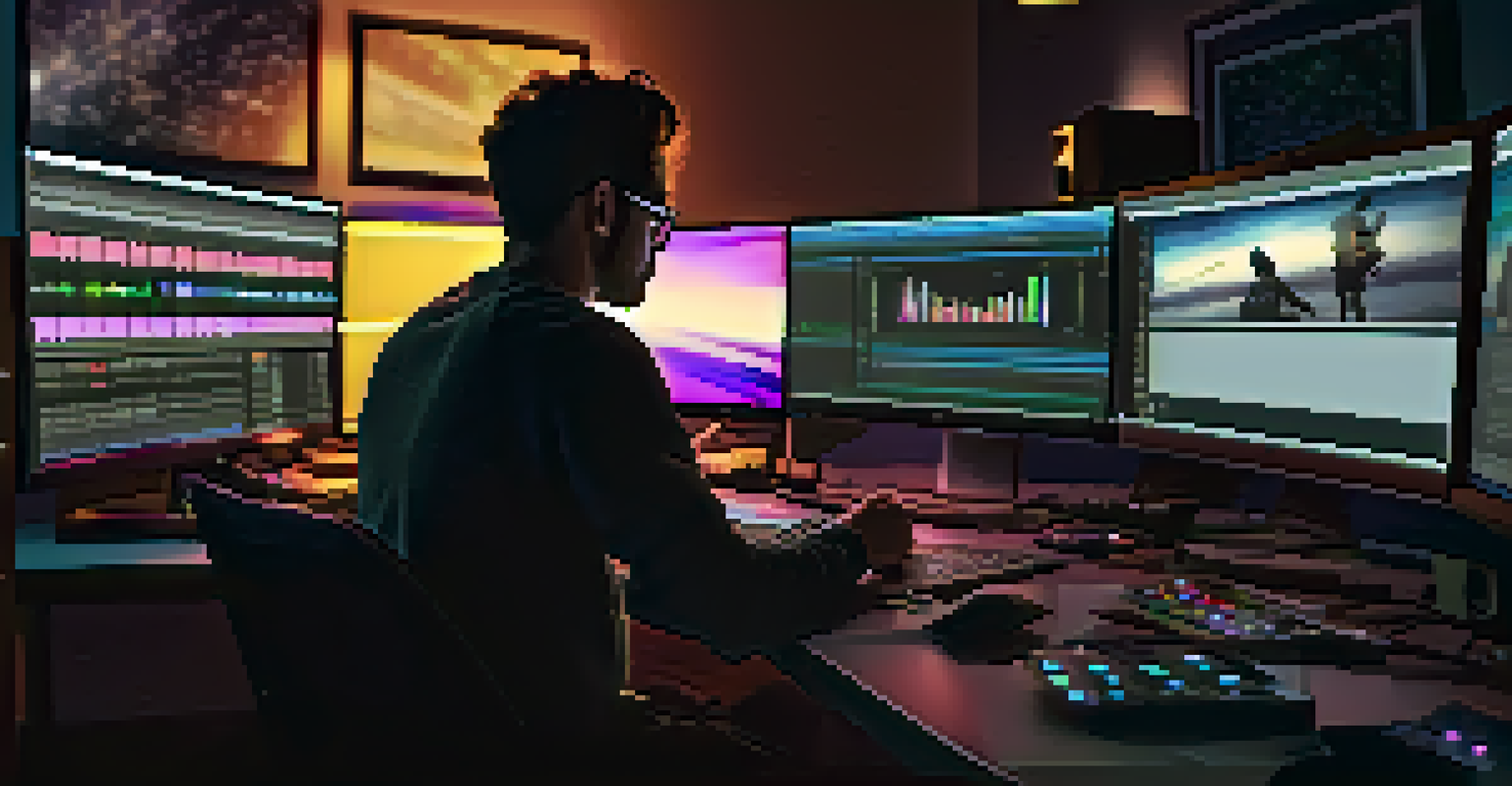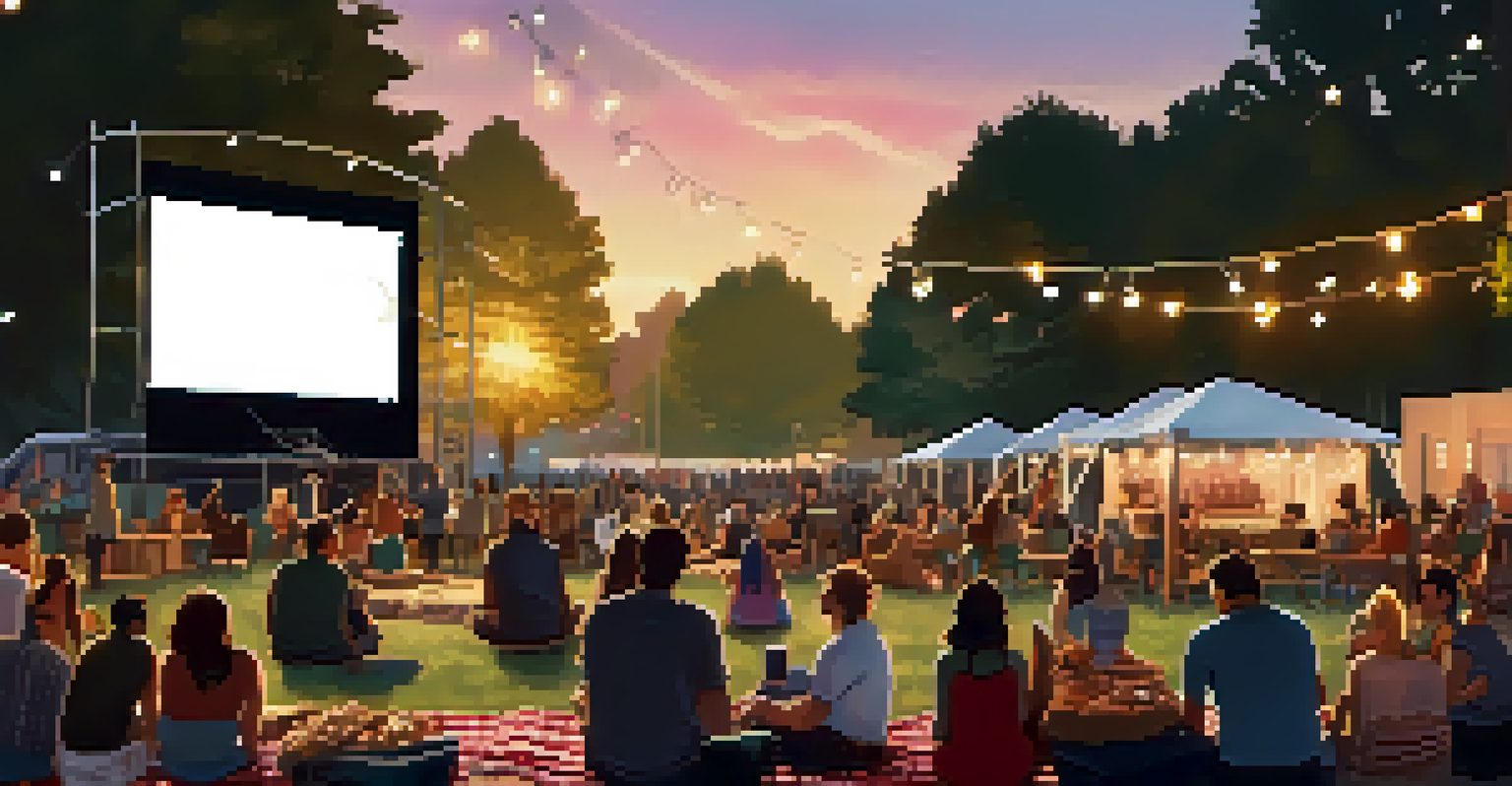Cinematic Techniques: Hollywood's Impact on Global Filmmaking

The Evolution of Cinematic Techniques in Hollywood
Hollywood has long been at the forefront of cinematic innovation, continuously developing techniques that push the boundaries of storytelling. From the early days of silent films to the advent of sound and color, each era has introduced new methods that have transformed audience experiences. These advancements not only revolutionized the industry but also set standards that filmmakers around the globe aspire to meet.
Film is a powerful means of expression and can be used to communicate ideas and feelings that are often difficult to articulate in words.
For instance, the introduction of Technicolor in the 1930s brought vibrancy to films, making stories more visually engaging. This leap in technology inspired international filmmakers to adopt similar innovations in their own productions, often blending local narratives with Hollywood's cinematic flair. As a result, audiences worldwide began to expect high production values, pushing local industries to elevate their craft.
Moreover, Hollywood's embrace of digital filmmaking has influenced countless filmmakers in various countries. The ease of editing and special effects available today has democratized filmmaking, allowing even independent filmmakers in remote locations to create visually stunning content. This shift showcases how Hollywood's evolution impacts global cinema, inspiring creativity and new approaches worldwide.
Narrative Structures Influenced by Hollywood
Hollywood's storytelling techniques have set a template for narratives that resonate globally. The classic three-act structure, which includes setup, confrontation, and resolution, is a blueprint that many filmmakers outside of the U.S. have adopted. This approach not only provides a clear framework for storytelling but also ensures that audiences can easily follow the plot, regardless of cultural background.

Consider the global success of films like 'The Lion King' or 'Titanic', which utilize this familiar structure to engage viewers emotionally. As filmmakers from diverse cultures attempt to reach wider audiences, they often incorporate these tried-and-true narrative elements into their storytelling. This blending of styles can lead to unique films that reflect both local traditions and Hollywood's influence.
Hollywood's Influence on Global Cinema
Hollywood's innovative cinematic techniques have set industry standards that filmmakers worldwide strive to emulate.
However, while many filmmakers embrace Hollywood's narrative styles, there's a growing trend toward hybrid storytelling that incorporates local customs and folklore. By merging these global techniques with indigenous narratives, filmmakers enhance their stories' authenticity while still appealing to a broader audience. This creative fusion showcases the evolving nature of storytelling in the global film landscape.
Cinematography: A Visual Language from Hollywood
Cinematography plays a crucial role in shaping how stories are told on screen, and Hollywood has been a major influencer in this regard. The techniques developed in Hollywood, from camera angles to lighting, have been emulated by filmmakers worldwide. For example, the use of dramatic close-ups can intensify emotions, a method often seen in Hollywood blockbusters that has been adopted by filmmakers in various cultures.
Cinema is a language. It can say things that you can’t say in any other way.
Furthermore, the establishment of specific genres such as action, horror, and romance has led to the creation of visual codes that audiences instantly recognize. These codes help filmmakers communicate ideas more effectively, allowing for a shared understanding of visual storytelling. Global cinema increasingly borrows these visual languages, adapting them to fit local contexts and narratives.
The result is a rich tapestry of films that reflect a blend of influences, showcasing how Hollywood's cinematographic techniques have permeated global filmmaking. As audiences become more sophisticated, the expectation for high-quality visuals continues to rise, pushing filmmakers everywhere to refine their craft and learn from Hollywood's legacy.
Editing Techniques: Crafting the Rhythm of Storytelling
Editing is often referred to as the invisible art of filmmaking, yet it profoundly impacts how stories are perceived. Hollywood has pioneered numerous editing techniques that have become standard practice in the industry, influencing filmmakers across the globe. For instance, the use of cross-cutting to build tension and intertwine storylines has been widely adopted, enhancing narrative complexity in films worldwide.
Moreover, the rhythm of editing can dictate a film's pace, influencing the viewer's emotional journey. Fast-paced editing, often seen in action films, keeps audiences on the edge of their seats, while slower cuts can create a reflective mood. As international filmmakers adopt these techniques, they often blend them with their styles, resulting in unique cinematic experiences that resonate with local audiences.
Narrative Structures Adopted Globally
The classic three-act structure popularized by Hollywood has become a blueprint for storytelling across various cultures.
This evolution in editing reflects the broader trend of globalization in cinema, where filmmakers share techniques and ideas across borders. Through workshops, film festivals, and online platforms, the exchange of knowledge about editing practices fosters creativity, allowing filmmakers to craft stories that are both engaging and culturally relevant.
Sound Design: Crafting the Auditory Experience
Sound design is a critical element of filmmaking that shapes the audience's experience, and Hollywood has set the bar high. From the use of diegetic sounds that enhance realism to non-diegetic music that heightens emotional response, Hollywood's approach to sound has influenced how films are made worldwide. Filmmakers recognize that sound can evoke feelings and set the tone, leading them to adopt similar techniques to create immersive experiences.
For instance, the iconic score of a Hollywood film can instantly transport viewers into the narrative, making them feel connected to the characters and their journeys. This understanding of sound's emotional power has encouraged global filmmakers to invest in high-quality sound design, often collaborating with talented sound artists to achieve similar effects. As a result, films from non-Hollywood countries are increasingly recognized for their compelling soundscapes.
Additionally, the rise of advanced audio technology has made it easier for filmmakers worldwide to enhance their sound design. With access to sophisticated software and equipment, independent filmmakers can produce high-quality soundtracks that rival Hollywood productions. This democratization of sound design enables a diverse array of voices to be heard in the cinematic landscape, enriching the art of storytelling.
The Globalization of Hollywood Culture
The globalization of Hollywood culture has profoundly impacted cinematic techniques used around the world. As American films dominate international box offices, their styles and standards have seeped into the filmmaking practices of other countries. This cultural influence extends beyond mere aesthetics; it shapes the themes, characters, and narratives that resonate with audiences globally.
For example, many international films now incorporate Hollywood-style marketing strategies and production values to attract wider audiences. By adopting these methods, filmmakers aim to enhance their visibility and competitiveness in a crowded market. This blending of Hollywood's commercial approach with local storytelling traditions creates a unique cinematic identity that reflects both global and local influences.
Emerging Trends in Filmmaking
Advancements in technology and a focus on diversity are driving the evolution of cinematic techniques, blending local narratives with Hollywood influences.
However, this influence can also lead to concerns about cultural homogenization, where unique voices and narratives may be overshadowed by mainstream trends. Filmmakers are increasingly tasked with balancing the allure of Hollywood techniques with the authenticity of their cultural heritage. This ongoing conversation about cultural identity in cinema enriches the global film landscape, encouraging diverse expressions of storytelling.
Future Trends: The Evolution of Cinematic Techniques
As technology continues to evolve, so too will the cinematic techniques that filmmakers employ. The rise of virtual reality (VR) and augmented reality (AR) is beginning to reshape how stories are told, offering immersive experiences that Hollywood is eager to explore. These advancements not only present new opportunities for filmmakers but also challenge traditional storytelling methods, encouraging innovation worldwide.
Moreover, the growing emphasis on diversity and representation in cinema is leading to a broader range of stories being told. Filmmakers are increasingly drawing from their cultural backgrounds to create narratives that reflect their unique perspectives while incorporating Hollywood techniques. This fusion of styles not only enriches storytelling but also fosters a more inclusive cinematic landscape.

In conclusion, as Hollywood continues to influence global filmmaking, the future will likely see an ongoing exchange of ideas and techniques. Filmmakers worldwide will adapt and innovate, creating a dynamic film culture that honors local traditions while embracing the best practices from Hollywood. This evolution ensures that cinema remains a powerful medium for storytelling, capable of bridging cultures and connecting audiences across the globe.